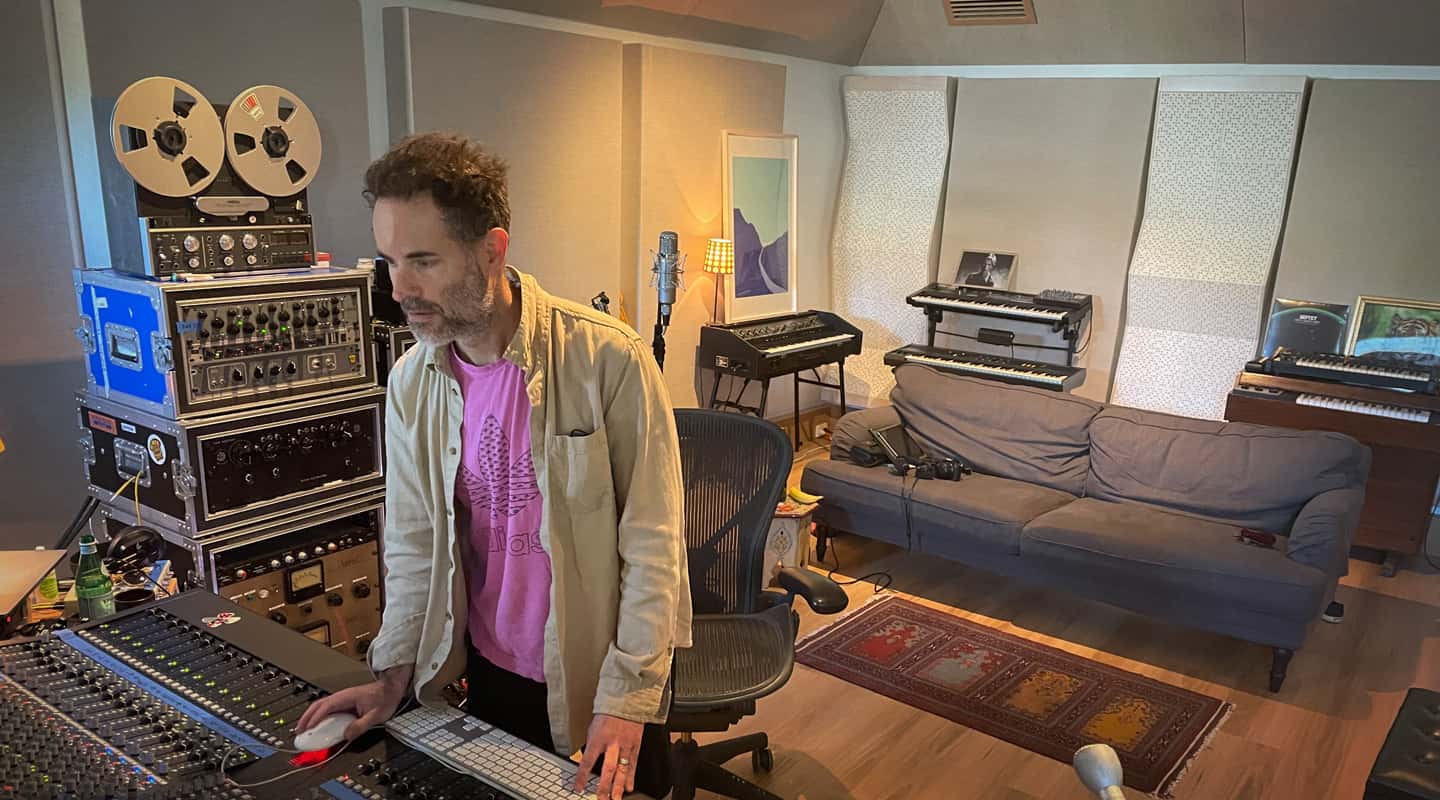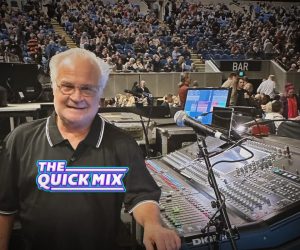
Tony Buchen Interview
Tony Buchen (Smashing Pumpkins, John Carroll Kirby, Montaigne, John Butler Trio, The Preatures, The Crystal Method) is an ARIA-nominated record producer, composer, mixer and songwriter now based at the Church Street Studio complex in Camperdown. AT pays a visit to his new gaff.
Tony Buchen is back from L.A. Perhaps not exactly in the timing or manner that he’d imagined, but Covid does that. His L.A. studio came with him in a shipping container. Curiously, he purchased a 32-channel SSL Origin from a mate at Vintage King not long before hopping on the plane back to Sydney. Only ‘curious’ because it had to be crated up (unused) and fork-lifted into the container with the rest of his cache of desirable guitars, synths and outboard.
Before Tony sought his fortune in the US he had a production space at the old Studios 301 in Alexandria. Everything was laid on: assistant engineers, a receptionist, muffins… Finding himself back in Australia he needed a studio pied-á-terre, and quick. Composer Guy Gross obliged making a space on the top floor of his Church Street Studios in Camperdown available. In fact, while Tony was still in La La Land he was working out the dimensions and the acoustic vibe with Guy and acoustician James Webeck.
The new room is versatile and sounds awesome. Perfect for mixing, and just as suited to recording an acoustic guitar or a vocal. There’s a shared live room next door. Tony Buchen is a happy man. We caught up with him to hear more about his journey and the new space.
LA CONFIDENTIAL
AT: It’s always interesting talking to Aussie producers returning from a US campaign. What was your experience like?
Tony Buchen: L.A. is a very different ecosystem. You’re still making music; you’re still creating… so for me, in terms of the work, it didn’t change. But in terms of the ecosystem, it’s very different, and you’ve got to adapt. In L.A., you’re in this epicentre of creativity, where being ‘really talented’ gets you only so far because there are literally five people in the same building who could mix this track and do a great job. So at the end of the day, you have to shed ideas about your competency and start asking yourself about who you are as an artist and what you’re saying. If you don’t bring something really amazing and something new, then you’re just not really going to go anywhere in L.A. In my case I might have Rob Schnapf across the street working with Cat Power one day and Kurt Vile the next.
AT: Finding the right space and the right precinct for a studio seems important.
Tony Buchen: It is and in L.A. it’s a challenge. You can, of course, try to get a room at a big studio like United or Sunset, but the rents are exorbitant. They do have a few producer suites, but they’re reserved for people that are really flying at the top of their career in L.A. — producers who have just won a Grammy, or the likes of Daft Punk, for example. When I arrived in L.A. I had a little black book with contacts but nothing that allowed me to walk into a situation like that. Instead, I took a room in a real indie kinda community in Northeast L.A., which I loved.
Being close and adjacent to musicians doing things makes sense. As a producer working with great musicians really keeps you on your toes. I mean, you better be on form, because yesterday they were with another producer down the hallway and they had a good time. You want every session to feel great for everyone. In L.A. you’re always reminded that the session musicians are the ones spreading the word about whether you run a good session, and if you don’t provide an environment where they feel they can create… well, then it’s just not going to sound good.
Coming back to Australia, it was that inspiring sense of an artistic community that attracted me to what Guy Gross is got going on at Church Street Studios. He really wants to create a community.


AT: Tell us about the new studio’s design.
Tony Buchen: For starters, it’s a slightly coffin-shaped room, to deal with some standing waves. It’s also the biggest control room that I’ve ever had. I mean, the couch is actually off the back wall, which is a luxury. And it fits all my gear.
It’s a mix room with my SSL console, but I wanted it to be more versatile than that. I didn’t want it to be a dead acoustic space. If I’m recording an acoustic guitar I wanted the environment to be conducive to that, or a vocal performance, even.
James Webeck’s instinct is to start live and it’s easier to shut the acoustic down if you need to. But start with some life. That said, the approach was to start with it as dead as possible near the console. That way, when I’m in the sweetspot I’m just hearing the studio monitors. And then as you go to the back of the room, it opens up a little bit. We have some nice diffusers at the back of the room, with 1960s perforated tiling that I brought back from L.A. I’m really happy with the result.

ORIGIN: THE SPECIES
AT: The SSL Origin purchase must have been a big decision. What’s the rationale?
Tony Buchen: It all stems from how I learnt to mix. I learnt with an engineer called James Cadsky, a name familiar to many of your readers, I’m sure. James had a studio in Sydney called The Vault, which had an SSL E series — a classic ’80s mixing console that you could really drive — as a result it sounded more vintage than subsequent SSL releases. I learnt on that console sitting alongside James.
When I moved to Studios 301, I was mixing on the SSL ‘K’ Series there, which had some very powerful features and automation but it didn’t sound as crunchy — it’s not a console you can drive; it’s built to provide pristine sound.
Alongside that I was working in the box more and more, albeit using a Shadow Hills summing mixer.
At that time, I missed not being on a mixing console, and like many others who learnt their craft on a large mixer, I guess I felt like bit of a fraud. I was delivering good mixes and clients were happy with my work but the nagging feeling was: I’m not really doing what I truly know I can do. A mixing console gives you an extra level of control and you’re relinquishing some of that by mixing in the box, for sure.
The point is, I’ve always wanted to get back on a board but I was conflicted because I just couldn’t get my head around buying a mixing console… even ethically, I’m not going to own a console that requires an air conditioner to cool a power supply 24/7. I was resigned to giving up on that dream.
I was at the NAMM show in 2018 when SSL was launching the Origin. I couldn’t resist hopping on. I grabbed some EQ and immediately knew, yes, this was an SSL. And it also has a Drive feature on the channels, which makes it a bit more like the E-series consoles, where you can drive the input a bit more. It also has power saving features, which impressed me. It was ticking boxes. I knew I had to have it… Screw it!
AT: Mixing consoles are enjoying a mini renaissance. Were you quite sure the Origin was the pick of the bunch compared to the equivalent Neve or API?
Tony Buchen: I was at Vintage King in L.A. and it’s gotta be the one place in the world where you actually have the three consoles in front of you, all connected. I tried the API and it’s beautiful. If it’s a competition to be best summing mixer, the API would win every time because it has this depth to it and it’s beautifully made. But in terms of usability, there’s no question for me that the SSL is a way more creative console than both the Neve or the API… at least for the way I like to work. Plus, for me, there’s an instant familiarity with SSL — I immediately feel at home behind an SSL.
AT: How do you incorporate the SSL Origin into your workflow?
Tony Buchen: I’ll do 90 percent of the mix in ProTools. I then put it up on the board (run with most of the SSL large faders at unity) and route some aspects of the mix through speciality analogue outboard, and use some hardware mix bus processing. It’s like using the Origin as a kind of summing mixer with EQ and routing benefits.
AT: Would you insert your hardware processing into the individual channels?
Tony Buchen: More likely I’ll use the small faders to send to parallel compression, for example. Sometimes I have hardware inserts on channels and sometimes I’ll still use software inserts in Pro Tools where appropriate. Having those analogue returns coming up the desk help me to inform my mix decisions more than in the Pro Tools environment. I acknowledge that it’s an esoteric world that I’m talking about but for me it’s more beautiful — those sounds on the console are more present and exist for me in the real world.


AT: And presumably the inserts on your mix bus are pretty consistent from mix to mix.
Tony Buchen: Interestingly, I’ve worked out a pretty unorthodox hybrid approach to the mix bus. Some people might think it’s just a bit nuts, but like I go out and in again through plugins such that when I press the large fader insert on the mix bus, I’m actually inserting plugins as well as analogue outboard. The reason for that? There are plugins that are required on the mix bus that are very hard to replicate in the analogue domain. I have a Manly VariMu, an old peak limiter and other hardware items that are great on the mix bus there are certain ProTools mix bus plugins that are so exciting to me that I can’t live without them.
RECALL SCRAMBLE
AT: One of the most compelling advantages of working in the box is instant mix recall. Does the SSL Origin have any recall features?
Tony Buchen: No, and it’s something I’ve had to give a lot of thought about. For me it’s started with having a great assistant. Ollie Brown has his own studio across the hall and is a real up and coming talent in his own right. Together we’ve been working on a process for recalling a mix. We’ve got it down to about a 10 or 15 minutes turnaround.
AT: What’s the secret beyond taking a bunch of photos of knobs?
Tony Buchen: It’s about taking photos of knobs [laughs]! Because the console doesn’t have a computer like the SSL K does, where it tells you the position of pots and faders, you need to have your own system. And in the end it comes down to how I use the console, and it being compatible with a super-fast recall.
This isn’t an original idea but you must be disciplined in making sure your bass parts always comes up the same channel; same with vocals, drums etc. It’s about keeping everything you can locked into a set signal flow. That way the EQ and routing remains largely unchanged and I can make adjustments quickly and creatively rather than spending time at the patchbay. This means, in terms of the recall, I’m just making small adjustments to the analogue gear a lot of the time. The radical changes happen in Pro Tools sessions which are 100% recallable, obviously.

AT: Finally, Tony, what sort of pandemic did you have? Do you fit into the ‘what doesn’t kill you…’ category?
Tony Buchen: It’s undoubtedly been a shocking few years for the creative industries. And I’ve learnt a lot about what makes me tick in the studio when a lot of what you hold dear gets taken away. But I’ve been very fortunate to have made some great records remotely and have never been wanting for work. I think the biggest ‘take home’ for me is to always see setbacks as opportunities. If something gets cancelled in my schedule, I’m thinking, okay, I’ve got free time to create. Sure, it’s a bummer that the gig was cancelled. And, even though you could very easily go down that rabbit hole of thinking the universe has turned on you, it doesn’t actually do you any good to think about things in those terms. So Covid definitely tested that philosophy in ways I never thought anything would. But, ultimately, it’s been a great opportunity to do some interesting shit, notwithstanding the pain and suffering that was going on in the world which has weighed very heavily on all of us.



























RESPONSES